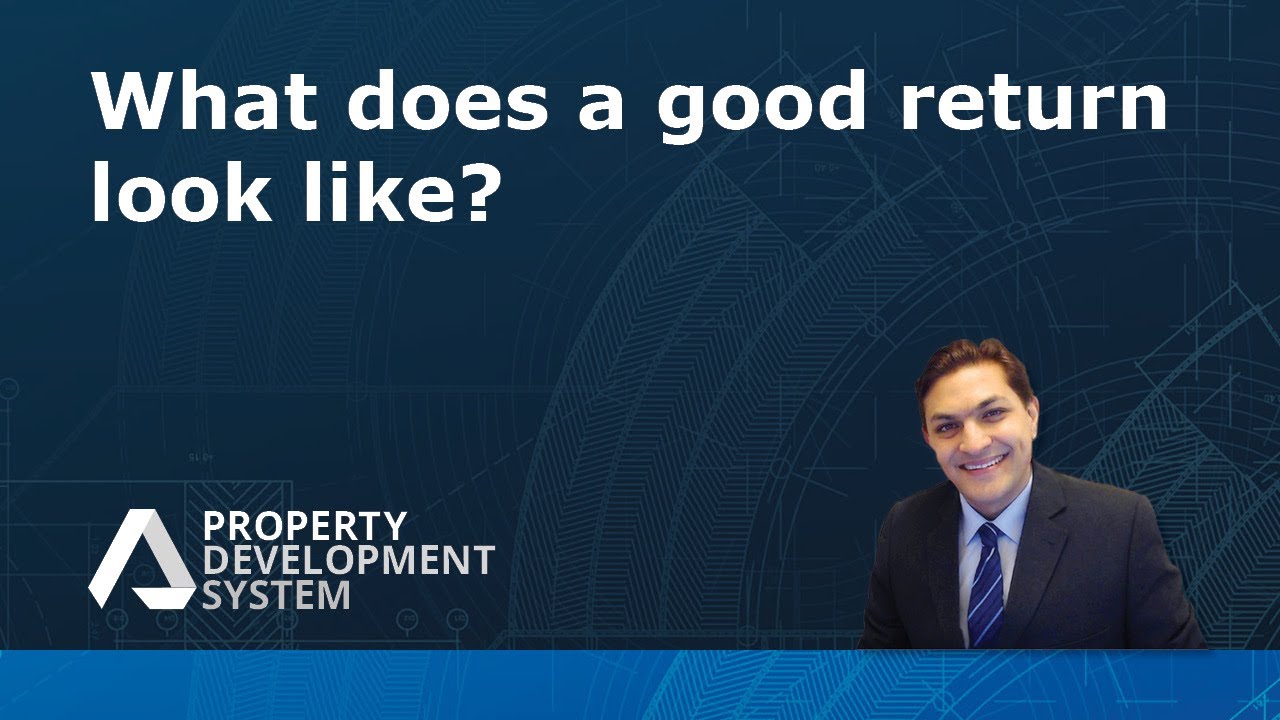What does a good return look like?
This article covers key decision metrics and financial feasibility in real estate development, focusing on what constitutes a “good return” on commercial and residential projects. Here’s a breakdown:
Commercial Projects
A good return is around 20% on cost, known as the development margin.
Residential Projects
For smaller scale residential projects, a return between 12% to 15% is typical, especially for projects with plans and permits already issued for their best possible use.
Project Specific
Acceptable returns vary and are specific to the amount of risk one is willing to take. Higher risks should ideally offer higher returns.
Financial Metrics:
Basic Profit
Revenue minus all costs, including land value.
Development Margin on Cost
Net profit divided by total cost, expressed as a percentage.
Residual Value of Land
Essential for appraising land based on potential development, reflecting the project-specific site value.
Capitalisation Rate (Cap Rate)
A fundamental concept in commercial real estate is representing the return on investment property based on expected income.
Insights based on numbers
- The thresholds for a “good return” highlight the financial benchmarks professionals target in real estate development.
- The distinction between commercial and residential project returns underscores the varying risk and revenue profiles of different real estate segments.
- The explanation of financial metrics like the development margin, residual land value, and cap rate provides a foundational understanding of project valuation and feasibility assessment.
Frequently Asked Questions
How does the risk associated with a real estate project affect its expected return?
For investments where a substantial amount of money is at risk, investors expect a higher return to compensate for the increased risk. This principle applies across different types of real estate projects, whether commercial or residential.
Acceptable returns are project-specific, meaning the required return rate varies depending on the risk profile of each individual project. For example, projects with higher uncertainty or those that involve more complex development processes might necessitate higher returns to make the risk worthwhile for investors. This risk-return relationship is fundamental to financial feasibility assessments in real estate, guiding investors to make decisions that align with their risk tolerance and financial objectives.
Can the development margin vary significantly between projects of similar scale but in different locations?
The development margin can indeed vary significantly between projects of similar scale but located in different areas. This variation is primarily due to factors such as the presence or absence of permits and the highest and best possible use of the site. For instance, a smaller residential project might target a development margin between 12% to 15%, but this range can change based on the project’s specifics, including its location.
How is the residual value of land calculated for a project with the potential for higher-density development?
The residual value of land is described as a crucial metric used to appraise land based on the specific development that can be realised on it. This value changes with the project’s schematics, such as the number of townhouses or apartments that can be built on the land.
For a project with the potential for higher density development, the residual land value reflects the increased revenue potential from having more units on the same piece of land. The calculation considers the revenue minus all costs, including profit, which represents the money available for the purchase of the land. This is derived from the completed development’s value minus the development costs and profit. The formula adjusts based on the target development margin or the entrepreneurial risk margin, indicating the maximum price a developer would be willing to pay for the land to achieve the desired development margin.
This approach to calculating the residual value of land shows how land appraisal is sensitive to what the developer plans to do with it, suggesting that the value can significantly increase if a higher density development is feasible and permitted. It underscores the dynamic nature of land valuation in real estate, where strategic planning and development proposals can influence the financial viability and potential return on investment.
What is considered a good return for commercial real estate projects?
A good return on commercial real estate projects is around 20% on cost. This rate is known as the development margin, which represents the profit margin developers aim for in these types of projects.
What is a typical return for residential real estate projects?
For smaller-scale residential real estate projects, a typical return ranges between 12% to 15%. This return expectation is particularly relevant for projects that have plans and permits already issued, ensuring they are developed to their best possible use.
Do acceptable returns vary by project?
Yes, acceptable returns on real estate projects can vary significantly and are specific to the amount of risk an investor is willing to take. Generally, higher-risk projects should offer the potential for higher returns to compensate for the increased risk.
What is Basic Profit in real estate?
Basic Profit in real estate refers to the revenue generated from the project minus all associated costs, including the value of the land. It represents the absolute profit figure before considering the investment’s efficiency or profitability ratios.
How is the Development Margin on Cost calculated?
The Development Margin on Cost is calculated by dividing the net profit by the total cost of the project, including land value, construction costs, and other expenses. This figure is expressed as a percentage and indicates the efficiency and profitability of a real estate development project.
What is the Residual Value of Land?
The Residual Value of Land is a valuation metric essential for appraising land based on its potential development. It reflects the value of a site-specific to a particular project, considering the revenue it can generate once developed.
What does the Capitalization Rate (Cap Rate) represent?
The Capitalization Rate, or Cap Rate, is a fundamental concept in commercial real estate that represents the return on an investment property expected based on its income. It’s calculated by dividing the annual income generated by the property by its current market value, providing insight into the property’s yield and investment attractiveness.
Why are the thresholds for a “good return” important in real estate development?
The thresholds for a “good return” are important because they provide financial benchmarks that professionals in the real estate development sector target. These benchmarks help developers and investors set realistic expectations and guide their investment and development strategies.
How do the returns differ between commercial and residential projects?
The returns between commercial and residential projects differ due to the varying risk and revenue profiles of these real estate segments. Commercial projects typically target higher returns around 20% due to their larger scale and higher inherent risks. In contrast, residential projects aim for returns between 12% to 15%, reflecting their smaller scale and potentially lower risk.
Why is understanding financial metrics like development margin and cap rate important?
Understanding financial metrics such as the development margin, residual land value, and cap rate is crucial for assessing the feasibility and valuation of real estate projects. These metrics provide a foundational understanding of how to evaluate the profitability and investment potential of development projects, enabling more informed decision-making.
Test Your Knowledge
Multiple Choice Questions on Real Estate Development Returns and Metrics
1. What is considered a good return on cost for commercial real estate projects?
A) 10%
B) 15%
C) 20%
D) 25%
2. For smaller-scale residential projects, the typical return on cost falls within which range?
A) 8% to 10%
B) 12% to 15%
C) 18% to 20%
D) 22% to 25%
3. How is the development margin on cost calculated in real estate development?
A) Total cost divided by net profit, expressed as a percentage
B) Gross profit divided by total cost, expressed as a percentage
C) Net profit divided by total cost, expressed as a percentage
D) Revenue divided by net profit, expressed as a percentage
4. What does the residual value of land represent in real estate development?
A) The current market value of the land without considering its development potential
B) The cost of developing the land, including construction and permits
C) The value of the land based on its potential development, reflecting project-specific value
D) The depreciation value of the land over time
5. Which metric is a fundamental concept in commercial real estate that represents the return on investment property based on expected income?
A) Development Margin
B) Basic Profit
C) Capitalization Rate (Cap Rate)
D) Residual Value of Land
6. Which statement best describes the relationship between risk and returns in real estate development projects?
A) Lower risks are associated with higher returns to attract investors.
B) The level of risk does not influence the expected returns of a project.
C) Higher risks should ideally offer higher returns to compensate for the increased risk.
D) Returns decrease as the risk associated with a project increases.
7. What does basic profit in real estate development refer to?
A) Revenue minus the value of the land only
B) Revenue minus all costs, including land value
C) Net profit after accounting for development margin
D) Gross income generated from property leasing
8. Why is understanding the capitalisation rate (Cap Rate) important for investors in commercial real estate?
A) It indicates the potential increase in property value over time.
B) It represents the return on investment property based on expected income, helping assess investment attractiveness.
C) It calculates the total cost of developing a property, including land and construction.
D) It determines the resale value of the property upon project completion.
Answers:
- C) 20%
- B) 12% to 15%
- C) Net profit divided by total cost, expressed as a percentage
- C) The value of the land based on its potential development, reflecting project-specific value
- C) Capitalization Rate (Cap Rate)
- C) Higher risks should ideally offer higher returns to compensate for the increased risk.
- B) Revenue minus all costs, including land value
- B) It represents the return on investment property based on expected income, helping assess investment attractiveness.
Assignment
Real Estate Development Returns and Metrics: Practical Exercise
Objective:
To apply the concepts of real estate development returns and financial metrics through a series of practical exercises, reinforcing your understanding of what constitutes a “good return” on commercial and residential projects.
Exercise 1: Analyzing Returns
To Do:
- Choose a real estate development project you are interested in or create a hypothetical one. Specify whether it is commercial or residential.
- Research and list the typical costs involved in such a project, including land value, construction costs, permits, and any other relevant expenses.
- Estimate the revenue the project would generate once completed and operational or sold.
- Calculate the basic profit and development margin on cost for your project.
- What is the total cost of your project?
- What is the total revenue expected from your project?
- What is the basic profit?
- What is the development margin on cost? Does it fall within the “good return” range for its category (commercial or residential)?
Exercise 2: Risk vs. Return
To Do:
- Identify and describe three different real estate projects: one with low risk, one with medium risk, and one with high risk. Consider factors such as location, market demand, and economic stability.
- For each project, suggest an expected return percentage based on its risk level.
- How does the risk level affect the expected return for each project?
- Compare the expected returns with the “good return” benchmarks provided. Are they aligned? Why or why not?
Exercise 3: Financial Metrics Application
To Do:
- For the same project selected in Exercise 1, calculate the Residual Value of Land.
- If applicable (particularly for a commercial project), calculate the Capitalization Rate (Cap Rate) based on expected income.
- Explain how you determined the Residual Value of Land for your project.
- For commercial projects, what is the Cap Rate, and what does it indicate about your project’s investment potential?
- Find a real-world example of a commercial and a residential real estate project. What were the actual returns on these projects? How do they compare to the “good return” benchmarks discussed?
- Investigate how economic factors (such as interest rates, inflation, and market demand) can influence acceptable returns on real estate projects. Provide examples where possible.
Deliverables:
- A report detailing the analysis, calculations, and findings for Exercises 1, 2, and 3.
- Answers to the research questions, including examples and references.



